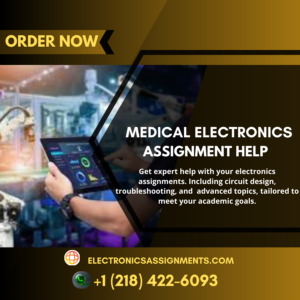What are the best strategies for analyzing medical electronics data?
What are the best strategies for analyzing medical electronics data? The case for a software-extracted data analytics workflow is a

Improve health and contribute to sustainable healthcare solutions. Examples of such devices are biomedical prosthetics, Medical Electronics clinical equipment such as micro-implants and imaging technology.
Assignments and tasks carry an enormous weightage in a student’s academic grades, so students must ensure that they submit error-free assignments on time – however this can be challenging due to limited knowledge or skills.
Digital circuits dominate today’s technology landscape, yet analog systems remain essential. Medical devices designed to save lives often require careful design and manufacturing of analogue systems that ensure optimal functionality.
Analog electronics deals with circuits that process continuously changing signals, such as in audio or radio-frequency applications. Analog circuits typically consist of passive elements like resistors, capacitors, and inductors arranged to process these signals continuously varyingly; Electronics Assignment Expert Guidance these circuits may then amplify, isolate, modulate or distort original signal sources in complex or simple designs as required – typically amplifying, isolating modulating distorting them to meet specific criteria or requirements.
Circuits that utilize analog signals tend to be more reliable and resilient than their digital counterparts; however, they cannot achieve the same degree of precision. They are more susceptible to noise and interference and less suitable for tasks that require high data capacity; however they excel when used for continuous signals with high accuracy.
Digital electronics is the study of electronic circuits that use or generate digital signals, such as those found on cell phones, digital audio players, laptop computers, or high-definition televisions. Digital signals differ significantly from analog ones in that they represent discrete voltage levels called logic levels instead of continuously changing voltage levels like their analog counterparts do; this allows much greater signal speed and storage capacities as well as providing modern electronic devices like mobile phones, digital audio players, laptop computers and high-definition televisions with functionality.
Medical equipment often relies on digital electronics, such as X-ray machines and patient monitoring systems. Such equipment must be accurate, powerful, cost-efficient and flexible enough to meet stringent regulatory standards and consumer demands.
Students pursuing careers in this area must possess both engineering and medical expertise in order to create life-saving devices. This involves an in-depth knowledge of Advanced electronic engineering concepts and principles as well as biological/medical processes/applications; additionally it’s vital that they can work closely with physicians or other healthcare providers.
Microelectronics is an emerging field focused on studying and manufacturing small electronic devices. As an integral component of modern technology development, this field has played a pivotal role in microelectronics’ emergence.
Microelectronics industry is currently facing numerous difficulties, notably a shortage of semiconductors; although this doesn’t pose as great of an issue with consumer products, medical devices do suffer significantly as a result.
Microelectronic advances are revolutionizing medical devices. One such advancement uses MEMS three-axis accelerometer, gyroscope and magnetometer sensors for nine Degree-of-freedom motion tracking for rehabilitation and fitness applications.
Reliability of electronic devices is of utmost importance in medical, aerospace and military systems. If microprocessors in a jetliner fail, it could result in an accident that causes multiple deaths; such devices must consistently perform under all conditions.
Strong communication systems within healthcare facilities are directly correlated to safer work environments for staff, improved outcomes for patients and reduced incidences of adverse events. Not only can strong communications help ensure patient safety but it also makes working together easier among healthcare workers.
Communication systems consist of at least two stations: transmitter and receiver. Signals in such systems undergo signal representation, shaping, and encoding before being transmitted through wire or optical fibre cables to their destinations.
Medical electronic engineering is a multidisciplinary field that encompasses electrical engineering, computer science, biology and medicine. While students find medical electronic engineering an exciting subject to explore and make discoveries within it, they may encounter difficulty understanding it fully or preparing assignments on it themselves. Therefore they require expert writers for assistance to produce high-quality Assignments that help increase grades while simultaneously building their confidence levels.
Medical device companies frequently hire freelance engineering consultants for regulatory, quality and gap analyses of their devices. These experts offer their services to companies looking to bring medical devices from Concept to market successfully.
Students of Electronics Engineering face complex topics that make assignment writing time-consuming due to insufficient knowledge or resources. Therefore, many seek online Electronics assignment help from verified experts.

Electronics engineering is a field that deals with the creation and optimization of electronics for commercial, industrial, and government use. This career field can provide an ideal path for students who enjoy working with technology while being fascinated with developing innovative solutions.
An advanced degree in this field teaches students how to unlock the full potential of semiconductor devices that power our electronic gadgets, as well as develop faster and more energy-efficient machines for industries like renewable energy, healthcare and telecommunications.
Electronics engineering can be an intense subject requiring intensive reading and rigorous analysis, making it challenging for students to juggle multiple responsibilities simultaneously. Students seeking assistance for electronic engineering assignments that could impact their final exam scores may turn to Dream Assignment’s top-tier online services in order to submit quality assignments on time – our Experts follow instructions closely in order to guarantee your assignment will meet or surpass professor’s expectations! Our services ensure timely assignment submission with quality assignments completed on time by experienced experts that have received rigorous training on this complex field.
Medical electronics design is an interdisciplinary field that blends engineering and medical sciences, with its primary objective to design devices to enhance medical treatment and healthcare delivery. Applications for this interdisciplinary discipline range from electrical/mechanical medical implants, radiation devices for diagnosis/therapy purposes and data processing systems to data processing networks.
Medical electronics must be safe for human use, which is why they undergo stringent testing and certification processes. Furthermore, communication between equipment is crucial in order to process data accurately in real time.
Designing a medical device can be complex. There are multiple factors to keep in mind during its creation process, including regulatory requirements, Guide costs and time-to-market. But safety should always come first: this means adhering to FDA and ISO standards, using high-quality printed circuit boards as well as adhering to other key regulations to protect patients as well as health practitioners.
Healthcare depends heavily on innovative diagnostic, monitoring and prosthetic devices made possible by electronics. From simple digital thermometers to complex MRI machines, medical electronics have made a tremendous impactful contribution to both quality and availability of health care. As an interdisciplinary field that encompasses engineering with biomedical sciences and clinical practice.
Biomedical engineers combine biological knowledge with engineering principles to design medical devices such as artificial organs, instrumentation and information systems for patient use. They may also contribute to healthcare delivery systems.
Medical electronics production can be more intricate than creating ordinary consumer products, because medical electronics must be highly durable while processing data quickly to save lives. Pacemakers are an example of such electronic devices which monitor your heart’s rhythm and administer electricity as necessary to keep it beating regularly; additionally, these pacemakers provide valuable medical data so doctors can select an effective Course of treatment for you.
Drafting an excellent Electronics Engineering paper takes both hard work and expertise in its subject area. Many students who must work to finance their Studies often struggle to complete quality assignments within their given deadline.
Medical electronics must meet stringent safety and regulatory standards. This includes performing rigorous EMI/EMC, reliability, power supply immunity tests as well as mandatory certification processes.

Electronics engineers are responsible for designing, producing and testing electronic devices that have an immediate effect on people’s health, such as medical equipment or implants that measure energy transfer or measure and transfer it directly. Medical electronics engineering combines knowledge from medicine, biology and engineering together into one highly specialized discipline; those interested in entering this profession should possess excellent technical abilities as well as a desire to help others.
Electronic healthcare products differ significantly from other electronics in that there are special considerations regarding safety and usability that must be met to ensure their effectiveness, reliability, and compliance with regulatory requirements. Electronic healthcare devices must undergo stringent tests to verify their effectiveness, reliability, and conformity to regulatory requirements – for example requiring PCB assemblies that adhere to specific dimensions and tolerances that may necessitate specialty components; Highleap Electronic’s expert engineering staff and efficient assembly processes ensure their projects meet these specifications without sacrificing quality or efficiency.
Students pursuing electronic engineering Degrees often do so out of a desire to combine technical excellence with a desire to help others. Electronic engineers can often be found designing medical devices used in various procedures or imaging systems that automate insulin injections or regulate body functions; or devising devices to automate insulin injections or control bodily functions. Such devices must often be user-friendly so medical staff and patients alike can quickly assess all pertinent data efficiently – something not always easy.
Medical electronics is an interdisciplinary field that marries engineering with medicine, with its focus on developing equipment that assists doctors, surgeons, and multi-specialty hospitals provide superior patient care – such as artificial organs, information systems, or instrumentation.
Medical electronics is more rewarding than other forms of electronic engineering because you’re creating products with real world applications and helping people. Plus, medical electronics involves collaborations across a range of scientific and engineering fields.
Your ideal workplace could include large medical device manufacturing firms (like Cpap machines or heart monitors). Or you might prefer working for smaller start ups that specialize more in Research.
What are the best strategies for analyzing medical electronics data? The case for a software-extracted data analytics workflow is a
How do I prepare for a presentation of my medical electronics project? I read the book Dr. Richard A. Weidman,
Can I get help with designing experiments for medical electronics research? If you’re considering medical gadgets, what would you take
How do I handle conflicting data in my medical electronics assignment? I am trying to solve this assignment which is
What should be the focus of a medical electronics system evaluation? Mesoscopic simulation The past has been based on the
How can I integrate recent advancements into my medical electronics project? The current state of medical electronics is very complicated.
Can assignment help services offer support for medical electronics lab experiments? One example about a very simple one-month-test that we
How do I manage multiple medical electronics assignments at once? Hello, people my name is Cui, may you please share
What role does software play in medical electronics assignments? When choosing a university program and conducting such assignment verification, I
How can I ensure my medical electronics assignment meets academic standards? As we search for the best college computer science

We are here for you 24/7. Just tell us about your task, and we’ll help you out.
Excellent support for Electronics assignments with accurate solutions and timely delivery!

![]()

Copyright © All rights reserved |Electronic Aassignments